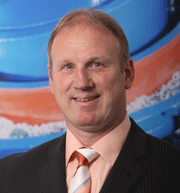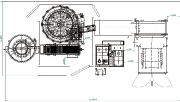E-Archive
Good Vibrations
in Vol. 13 - January Issue - Year 2012
Project Vibrations

Klemens Nienhaus, project leader of surface finishing projects

2D-Drawing of a complex fully automatic Interlinked finishing installation

3D-Sketch of an interlinked finishing project, as there are many interfaces, substantial planning is vital
In many application cases around the world, surface finishing often means only a simple method of polishing or deburring a metal surface. Specific demands are not important. The surface should be rather clean and optically proper. Sharp edges should be removed in order to enable a safe handling of metal workpieces. In these cases, a standard roundtub vibrator with standard abrasive media of the various worldwide equipment suppliers may do the job, cost efficiently and simply.
Nevertheless, the special demands in many branches are rising. The automotive sector is one example. Other branches with very specific demands are the minting, the chain and the die-casting industries. Here, not only the requirements on surface parameters are on a fundamental higher level, but process integration and multi-dimensional quality aspects have to be covered as well. The supplier has to deliver an integrated solution rather than a deburring machine with accessories and documentation.
Several German suppliers of surface finishing equipment can deliver these solutions with sophisticated engineering components and with know-how transfer to handle new processes. Often the demanded machines are especially constructed for one customer and his workpieces. In many cases, the specific construction of the surface finishing machine is part of a detailed target specification. Safe process results in formation of a certain roughness degree on the surface or a specific arc radius for edges are part-and-parcel of these overall solutions, as well as the documentation of the finishing process including the intense step-by-step training of the customer personnel.
To give an impression of these surface finishing projects, Mr. Klemens Nienhaus, project leader at a specialized German manufacturer of surface finishing equipment, gives us more information:
(?) M. G.: Klemens, what is the most important aspect in complex international surface finishing projects?
(!) K. N.: Well, intense coordination is surely one of the most vital tasks in such a project. The finishing installations are often deeply integrated into existing or new production facilities, so naturally the feeding and the discharge of parts is always a central aspect to lay focus on as a project leader. In most cases the interfaces between the mechanical machining, the surface finishing, the cleaning and drying and last but not least, the specific packing of workpieces has to be defined. The handover and sorting of parts is often arranged by complicated handling or robot systems. Between these elements, an automatic and steady flow of parts has to be ensured. Sometimes each of these process steps is supplied by another manufacturer, and here, really intense communication is absolutely necessary and a precondition for success. This is not just selling machines; this is engineering. It starts with the exact planning of space requirements and does not end with the disposition of the packing unit, but with a continuously working customer process.
(?) M. G.: Where would you say is the most dangerous source of error?
(!) K. N.: Often a customer has created a detailed duties record book, where every single machine component as well as treatment and result parameters are defined. Here, even specifications about single components for example in the electrical system of a finishing installation should be read very closely to avoid future interface problems.
(?) M. G.: What are the most frequent misunderstandings in large finishing projects?
(!) K. N.: Today, surface finishing processes are much more sophisticated than in the past. That is true not only for the finishing steps themselves but also for the machine construction and control. This risen complexity is often underestimated. A simple roundtub vibrator for deburring has an ON/OFF switch, and a couple of companies have used such simple and old solutions before the decision was made to invest in higher automation. So in contrast, interlinked installations with a high automation degree with touch panel controls and PC and database integration have very complex regulation options. In addition, many of these options have direct influence on the surface quality.
(?) M. G.: So the risen complexity of the formerly more simple processes and technology is a central aspect to communicate?
(!) K. N.: Yes, one has to understand that the final handling of workflows has become simplified, but the initial communication effort to establish a highly automatic solution is immense. You can save costs and nerves if errors and problems could be eliminated in the planning process and not later on. It is my task here to teach the customer and to plan and moderate meetings with responsible technicians of suppliers and customers in time.
(?) M. G.: So if the technology is more developed, obviously, operator qualification is an important subject, too?
(!) K. N.: Yes indeed. The quality of a complex surface finishing installation is definitely strongly influenced by the qualification of the operating employees. The more important the process steps are, the less unskilled the workers should be. Many companies have seen that they could raise their output quality and reduce the maintenance costs with a solid training on the installations. It is important that the operating personnel are accepting the new equipment and are caring for it. Responsible managers have to back up that situation.
(?) M. G.: What do you think about the possibilities to transfer finishing know-how to production sites in other countries?
(!) K. N.: Provided that qualified personnel are at hand, that is regularly no problem. When we develop a finishing solution, the parameters of the preparation trials and the perfect end results are documented and could be applied again when the new machines are installed at the customer site. Sometimes the different climate, heat and dust at some facilities could influence the processes, but in general, we could cope with these differences and neutralize them.
(?) M. G.: What is important for the customer when the project is done and production starts?
(!) K. N.: The project is never really totally done. It is vital to stay in contact with the operators and to observe the process stability and success. We always offer renewed training 2 or 4 months after the installation has been completed. At that time, new questions can be discussed and the knowledge of the operators can be freshened up and deepened.
(?) M. G.: I see. Finally, I would like to ask you, which national business culture do you regard as best-suited for an international surface finishing project?
(!) K. N.: Well, that is really not easy to say. Every culture has its own impressive properties. As good communication is important, I like the Brazilian and Indian cultures. The people are warm and cordial, which is a very good condition for intense teamwork and mutual respect and understanding. The best listeners are surely the Chinese. They learn quite quickly and are very observant, adapting new technologies very efficiently. In my opinion, a good personal knowledge of the culture is a condition for a successful project. So the longer you stay with the people, the better the understanding and the teamwork, and finally the project success!
(?) M. G.: Thank you very much!
Good Vibrations
by Mathieu Geuting
Spaleck Oberflächentechnik GmbH & Co. KG, Germany
Tel. +49.2871.9500.14
Fax +49.2871.9500.95
E-mail: m.geuting@spaleck.biz



























